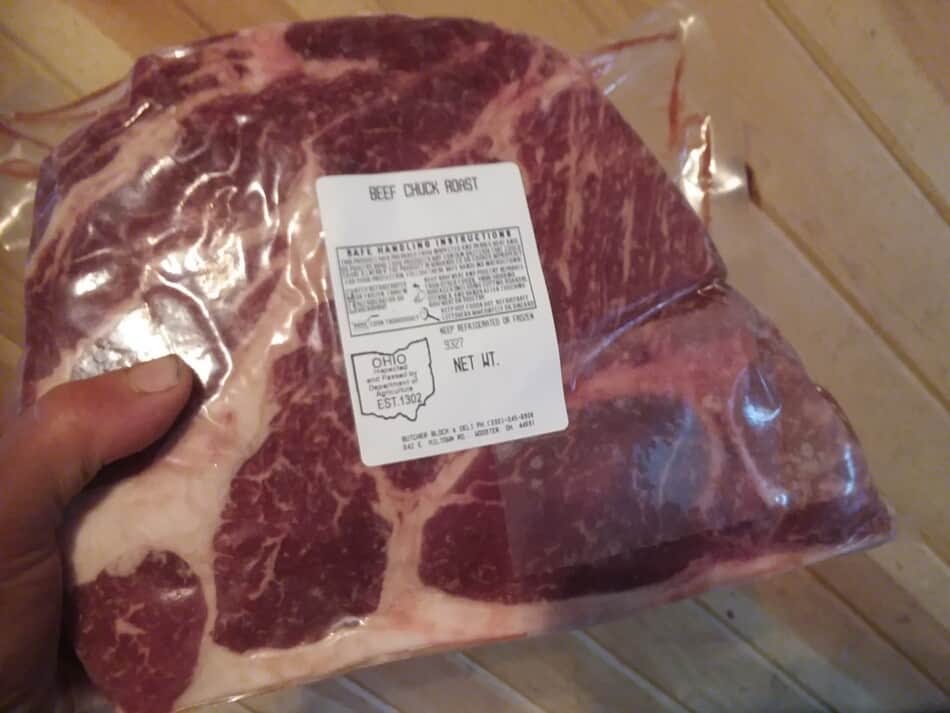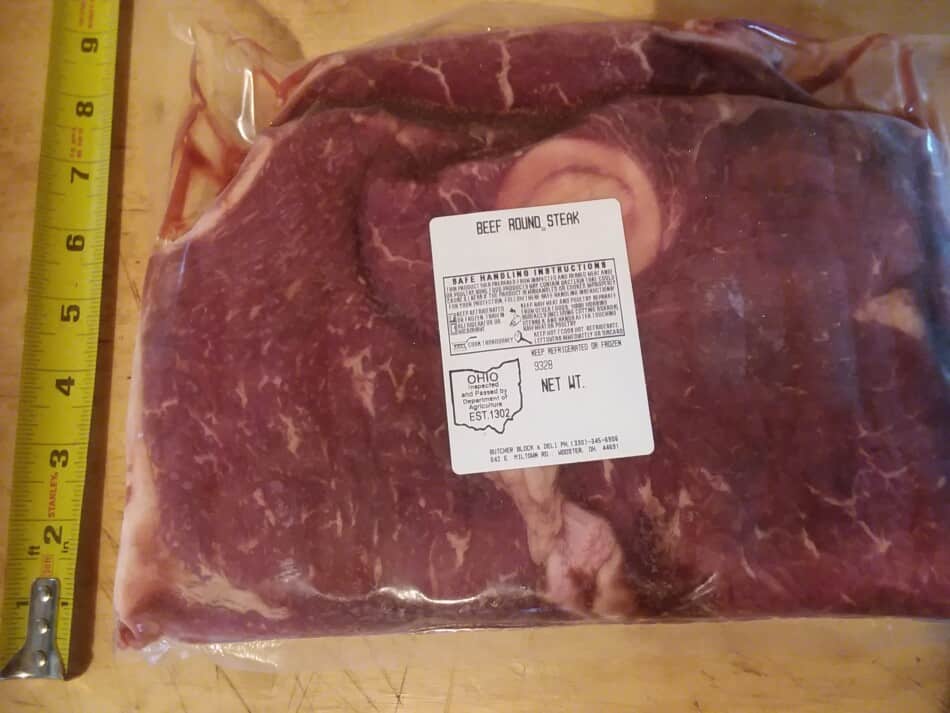Average Price for 3 Pounds of Ground Beef

Raising your own beef is your ticket to meat freedom! Before you can eat the best beef you've ever had, you'll need to get your steer processed.
What are the costs to butcher that amazing steer of yours and how much meat can you expect to get?
The cost to butcher your own beef is $1.74 per pound of freezer ready meat. A 1,000 pound steer will have an average of 430 pounds of meat with a total butchering cost of $750.
| Kill charge per head | $90 |
| Cutting, wrapping and freezing (per pound hanging weight) | $1.00 |
| Special instructions (per pound of meat) | $1.00+ |
| Vacuum sealing (per pound of meat) | $0.80 |
| Hanging weight of steer (% of live weight) | 61% |
| Meat in your freezer (% of live weight) | 43% |
| Butchering costs per pound of meat | $1.74 |
| Vacuum sealed meat (costs per pound of meat) | $2.54 |
All of the costs and considerations listed will apply to any beef animal you have butchered, steers, heifers, older brood cows, doesn't matter. I'll use the term steer for the rest of the article, to keep it simple.
Want more information on raising your own cattle? Read my article Getting Started With Beef Cattle.
Is Your Steer Ready To Butcher? shows you exactly what to look for on the steer to tell if he is finished or needs a bit more time to put on some marbling.
There will be a kill charge for your steer
For each beef animal you have butchered, there will be a kill charge of $80-100.
This is exactly what it sounds like. The kill charge is a fee to kill, gut and skin the steer. The kill charge is the same no matter the size of the steer. A 1,400 pound steer has the same kill charge as a 1,000 pounder.
This fee also covers proper disposal of the offal and the butcher shop keeping the hide.
If you want the hide, let them know. You'll need to pay them extra for it, since they have figured keeping the hide into the cost.

Know the live weight of the steer
To start figuring up your likely costs and amount of meat you'll end up with in the freezer, you'll need to know the live weight of the steer.
If you have no idea, take a guess of around 1,000 pounds. This number will be used to help you estimate, the butcher will weigh the hanging carcass and tell you the actual weight.
It isn't crucial that you know the exact weight of your steer, it's okay to guess.
In the end, the cost will be based on the butcher shop's numbers, not yours. These numbers are to give you an idea of what to expect, not to exactly determine final costs.
If you are a first timer, it's worth your effort to go through the calculations and get an idea of what you can expect to put in your freezer.
The hanging weight is 61% of live weight in cattle
The weight the butcher will give you is the hanging weight or the weight on the rail. This means the weight of the carcass after all of the guts, hide, feet and head are removed, but it has not aged yet.
The hanging weight it the number that will be used to figure up your costs for cutting, wrapping and freezing the meat.
For a great explanation of these numbers and to see where I got my stats from, check out Oklahoma Dept. of Ag, How Much Meat? It's easy to read and has great descriptive graphics.
An additional pricing structure for custom butchering beef
Here is another way to price custom butchering of your beef, charging by hanging weight.
The beauty of this pricing structure is in it's simplicity. One price based on the initial carcass weight.
The slaughter house I found using the hanging weight pricing system is 3-D Meats, of Dalton, Ohio. Here's how it works:
Take hanging weight of steer x $0.48 per pound, that's it.
If you had a 1,000 pound steer, you would get a hanging weight of 610 pounds. Take 610 pounds x $0.48=$292.80
With this pricing system there is no slaughter charge, just a price based on hanging weight.
Price does go up for a divided carcass, additional work like weighing packages individually and making patties.
The beef will age for two weeks
Now, the carcass will go into a cooler to hang and age for two weeks. I know that ageing is not a cost, but it is a consideration for you as far as when you'll actually get your beef, so I'm including it.
The aging process will allow the bacteria that is normally present in and on the carcass to start tenderizing the meat and concentrating the flavor.
I know it can be hard to wait for your meat! Ageing is an important part of the process and crucial to getting tender meat.
You've already put in quite a bit of time raising this steer, waiting a few weeks for ageing will make the most of the beef and the work you have already put in.
Your beef will be custom cut
Once the carcass has aged, it will be cut to your specifications.
Do some research here to see what you can do. No matter what you decide to have done with your meat, you'll want to have your mind made up when you drop of the steer.
If you are not sure what to ask for but would like a nice selection of meat cuts that the butcher normally makes, ask for their standard cut.
This is their most popular way to cut up a carcass that seems to make the most people happy and makes the best use of your animal.
If you have a specific cut that you want, mention this first. Your butcher will have a cut sheet that he goes over with you.
You'll be asked about:
- what cuts you want
- how thick (steaks) or heavy (roasts and ground beef) do you want them
- how many to a package (steaks and patties)
No matter what you order, there will be some ground beef. This is because some of the cuts will have edges that have to be trimmed. These trimmed pieces go into the grinder.
You should order the cuts you like, of course! However, keep in mind what you actually cook and be sure to get the cuts you use everyday.
For instance: if you use a lot of burger, but really don't cook too many roasts get fewer roasts and more ground or patties.

Meat is 43% of the steer's live weight
If your steer was 1,000 pounds live, you should get 610 pounds of meat, right? No. You'll have further loses in shrink and cutting making the total meat you get more along the lines of 43% of live weight.
When the carcass ages it will shrink. This is normal. This will result in a bit of total weight loss of the hanging carcass.
There will also be some cutting losses, extra fat that needs trimmed, but isn't needed for burger and bones that get cut out. Shrink and cutting loss will be another 18% loss in weight.
You could recover a bit of the cutting loss by getting the soup bones. I get the soup bones, they make great stock!
Butchering costs $1.00 per pound for beef
Once again, this is hanging weight priced.
If you have the standard steer that hangs at the standard 61% you'll be charged $610 for cutting, wrapping and freezing.
Any special treatment beef will cost more
All of the parts of your order that take more time than normal will also cost more per pound. It makes sense, since you are asking for more work to be done, it will cost more to do.
Examples of cuts or options that will cost more:
- Tenderizing
- Meat sticks
- Patties
- Vacuum sealing
The cost of these "extra" services will vary with patties being less expensive than beef sticks and the rest being somewhere in between.
Cost per pound of beef is $1.74
The butchering costs per pound of meat is $1.74.
This puts the total cost at $750, which includes the kill charge of $90, cutting costs of $610 and $50 for miscellaneous charges like tenderizing and having patties made.
$750 divided by 430 pounds of meat=$1.74 in butchering costs per pound of meat
If you wanted your order to be vacuum sealed, you would need to add another $344 bringing the total up to $1,094. This would be $2.54 in butchering costs per pound of meat.
430 pounds x $0.80 per pound vacuum sealing fee=$344
$750 + $344=$1,094 total butchering costs
$1,094 divided by 430 pounds of meat=$2.54 per pound of vacuum sealed meat
Calculate butcher costs for your area
On a final note, please research the costs in your area at your local butcher shop. These figures are listed to give you an idea of what to expect but will not be the same for every area.
If you find that your local butcher shop has drastically different pricing, do some math and see how the figures end up as far as total cost to butcher and package the beef.
What I have found is that the butcher shops all structure their pricing a bit differently, don't be surprised when you find this to be the case in your research.
Run through some of these calculations and you'll most likely find the final prices will be similar.
Is Raising Your Own Beef Worth It? shows you how to calculate up the costs of raising a few feeder steers versus buying beef from a like minded small farmer.
Source: https://familyfarmlivestock.com/cost-to-butcher-your-own-beef/
0 Response to "Average Price for 3 Pounds of Ground Beef"
Post a Comment